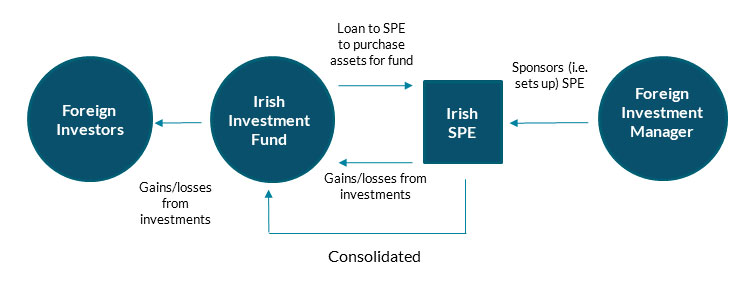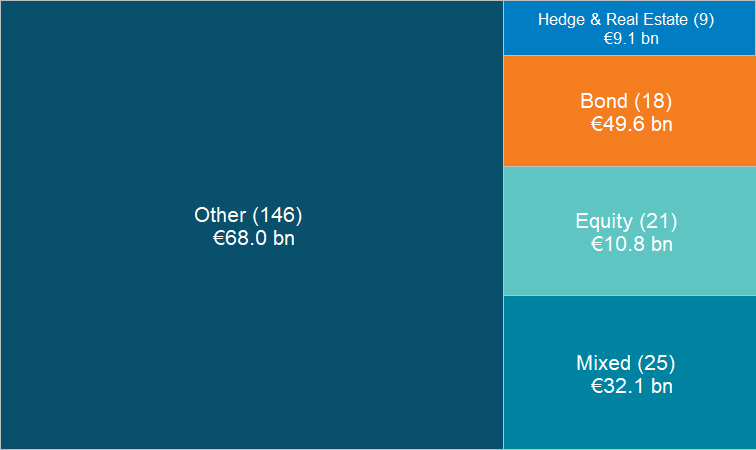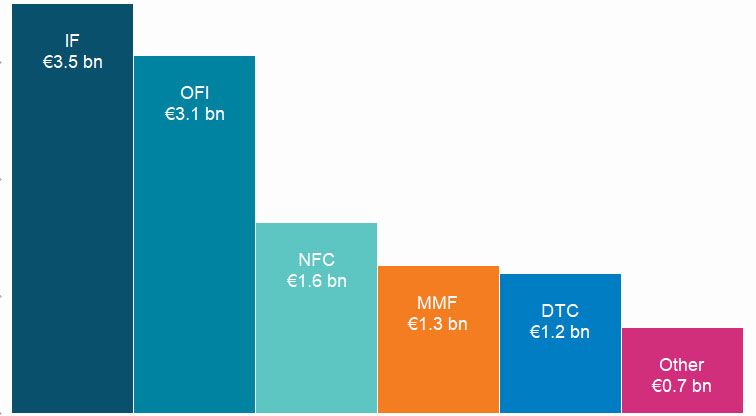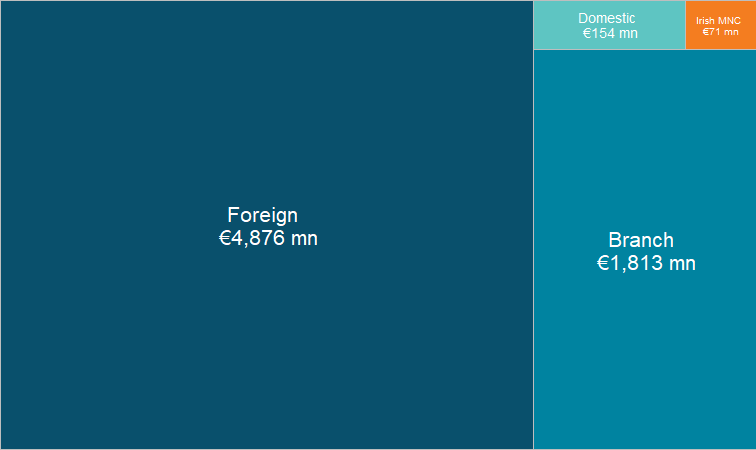Behind the Data

Do Special Purpose Entities hide domestic exposures from Investment Funds?
Brian Golden, Aisling Kerr and Arya Pillai*
July 2023
While Irish-resident Investment Funds (IFs) undertook €82 bn of portfolio investment through Irish-resident Special Purpose Entities as at Q3 2022, granular analysis suggest domestic links are far smaller while risks are much the same as if positions were held directly.
This Behind the Data focuses on Investment Funds (IF) employing Special Purpose Entities (SPEs) to undertake all or part of their portfolio investment. A SPE is a company specially created to fulfil a narrow, specific purpose (see SPE explainer, 2019). The IF industry in Ireland covers a wide range of activities and 4% of the population choose to employ SPEs to hold part of their portfolios. This extra layer of complexity within fund structures can reduce transparency as to the exposures that IFs are undertaking. This BTD shines a light on these exposures with respect to the domestic economy, given the possibility of this being a channel for transmission of external shocks within an increasingly fragile macro-financial environment amid rising interest rates. This also fulfils part of a recommendation from the IMF’s Financial Stability Assessment Programme on Ireland in 2022 (see IMF FSAP, 2022). This Behind the Data describes the data, explores why a IF might employ a SPE, identifying which IFs do so, the Irish-resident exposures and what portion of these are linked to the domestic economy.
The Data
The Q3 2022 quarterly returns filed by Money Market and Investment Funds (MMIF) and Special Purpose Entities (SPEs) (which includes Financial Vehicle Corporations or FVCs and Special Purpose Vehicles or SPVs) form the basis for this analysis. This BTD cross matches security level data from IFs on their holdings of SPE-issued instruments with SPEs identifying their IFs linked investment as their main activity when they register for statistical reporting to the Central Bank of Ireland (Central Bank). We identify instruments within the reported balance sheets of these SPEs which are linked to an Irish counterparty. Further, ISIN identifiers for each security are cross-matched with the Eurosystem’s Centralised Securities Database and IHS Markit data to identify the names of entities that SPEs invest in. Where this information was not available, an industry survey filled in the gaps.
This analysis builds on work undertaken by CBI within the IMF FSAP on Ireland to disaggregate an interconnectedness table into further sub-categories, one of which was IF links to SPEs.
Why would a fund employ a SPE?
Within a typical business model, the Irish-resident SPE is fully consolidated into the investment fund (Figure 1) (Golden & Hughes, 2018 & BIS, 2019). The SPE purchases assets financed by a loan from the fund, with profits or losses extracted from the SPE through interest payments on this loan to the fund. The investment manager, who is normally foreign, is responsible for setting up the SPE while investors, also normally foreign, hold shares/units in the fund, not the SPE.
Figure 1: Typical Fund-SPE business model structure

Source: Illustration based on Golden & Hughes (2018)
Notes: Sponsor refers to the entity that initiated the setup of an SPE or the structure the SPE is a part of.
This process allows the portfolio investment to take place in a company, the SPE, rather than within the fund. Portfolio investment through the SPE would need to comply with the investment mandate of the IF. Therefore, there is little reason to believe that there is any difference between IFs undertaking portfolio investment within the fund or in an SPE for the most part.
The key motivation appears to be tax efficiency. According to Dillon Eustace (2016): “alternative investment fund is used with one (or more) Section 110 subsidiaries as a structure (fund/Section 110 structure) to minimise withholding taxes on underlying investments. Alternatively the Section 110 company can be positioned above the fund to facilitate qualification for benefits of the Ireland/US double tax treaty.” Section 110 of the Irish Taxes Consolidation Act 1997 (S.110) provides various provisions that facilitate tax neutrality for activities that a SPE would undertake (Revenue, 2021). Theoretically, this could make portfolio investment through SPEs vulnerable to sudden unwinding in response to tax changes in Ireland or the countries of resident of investors in the IFs employing SPEs.
Which funds use SPEs?
A very small minority of funds employ SPEs. Total assets of these funds are €165.4 bn, 4% of a total fund population of €4.2 tn in Q3 2022, within which €90.6 bn are SPE-related. There are 219 funds using SPEs in this way, 3.2% of a total of 6,648 active funds. The distinguishing factor is that all funds employing SPEs are non-UCITS funds, known as alternative investment funds (AIFs). Unlike UCITs, AIFs are not marketed generally across investors, including retail investors, making them more suited to bespoke tax arrangements. The SPE-linked funds are spread across all fund types, although are predominantly in the “other” category, which contains funds that do not fit the equity, bond, mixed, hedge or real estate categories (Chart 1). Within “other” funds, around one-third of funds cite S.110 in their name, suggesting that availing of these tax provisions is a key attraction. These funds may be at somewhat higher risk of unwinding holdings in response to tax changes.
Separately, a non-portfolio exposure comes from fees and commissions with IF-linked SPEs paying €165 mn to Irish accountants, directors, lawyers and administrators in 2022, though paying very little in direct taxation.
Chart 1: Types of funds employing SPEs

Source: Authors calculations based on Quarterly Money Market and Investment Fund returns for Q3 2022.
Notes: The text within the graph shows fund type, count of funds (in brackets) and aggregate assets per fund type (last line).
What are the Irish-resident exposures within these SPEs?
The extent to which Irish-resident investment funds and SPEs were interlinked in Q3 2022 amounted to €90.6 bn. This is small relative to industry total assets of €3,527 in Q3 2022 but significant relative to Irish GNP at current prices of €356 bn in 2022. Within this, €9 bn represents funds holding debt issued by SPEs just as they hold debt issued by other entities, and hence were excluded from analysis. Funds undertaking portfolio investment through SPEs accounts for the remaining €81.6 bn. The SPEs and IFs included in the analysis required the SPE to have either an Irish-resident fund as sponsor, i.e. the entity ultimately responsible for setting up the SPE, or with a reported liability to the Irish-resident fund of over 40% of total liabilities. Within the portfolio investment of these SPEs, €11.3 bn relates to entities resident in Ireland, while €68.2bn reflects investment in foreign entities.
Focusing on the sectoral split of this €11.3 bn portfolio investment in Irish-resident entities, much of it takes place in sectors largely unrelated to the domestic economy. In these cases, funds flow through the Irish-resident entity to foreign individuals or entities. IFs commonly hold shares/units in Money Market Funds (MMFs) and other investment funds that invest in foreign assets. Such investment through SPEs amounted to €4.8 bn in Q3 2022. An additional €3.1 bn was invested in Other Financial Intermediaries (OFI), which largely represent flows through asset managers or other types of intermediate entity in order to gain exposure to certain assets. Though we lack visibility on the holdings of these OFIs, anecdotal evidence suggests that they are predominantly foreign assets. Furthermore, Collateralised Loan Obligations account for a significant portion of these asset holdings and this market is very limited within the domestic economy. The €1.2 bn in banks (Deposit Taking Corporations, DTC) represents deposits as opposed to portfolio holdings and are held with “IFSC” banks rather than domestically orientated banks. Most of the domestic exposure is within Non-Financial Corporations (NFC) or holding companies categorised as “Other” (Chart 2).
Chart 2: Portfolio investment into Irish-resident entities by sector

Source: Authors calculations based on Quarterly Financial Vehicle Corporation and Special Purpose Vehicle returns for Q3 2022.
Notes: The sector of the counterparty and aggregate assets per sector in € bn are shown in the chart
Do these SPE portfolios contain links to the domestic economy?
This section focuses on the counterparty split of this €11.3 bn portfolio investment in Irish-resident entities. To isolate domestic exposures within the NFC, DTC and Other sectors, the authors classified each counterparty name of Irish-resident entity as either (i) an Irish intermediary through which funds flows abroad, (ii) a Irish branch of an international entity, (iii) an Irish multinational company (MNC) or (iv) an entity whose operations are mostly within Ireland. For branches or Irish MNCs, funding from fund portfolio investment through SPEs would sustain operations with a significant Irish component but mostly taking place outside of Ireland. Domestic exposure is only a limited portion of portfolio investment in both categories. Portfolio investment into Irish-resident entities amounted to €6.9 bn in Q3 2002 (Chart 3). €4.8 bn related to foreign counterparties using Irish resident intermediaries like funds or OFIs. This leaves €1.8 bn with links to the domestic economy, predominantly comprising Irish branches of foreign entities. Only €154 mn relates to entities largely exposed to the domestic economy, comprising both banks and Non-Financial Corporations. There was an additional €4.4 bn outside of portfolio investment, mainly comprising “IFSC” bank deposits and loans between an SPE and its fund sponsor. This all implies only limited potential for IF-linked SPEs to channel external shocks to the Irish economy.
Chart 3: Irish-residents assets by counterparty type

Source: Authors calculations based on Quarterly Financial Vehicle Corporation and Special Purpose Vehicle returns for Q3 2022.
Notes: The sector of the counterparty and aggregate assets per sector in € bn are shown in the chart
Conclusions
This BTD provides transparency regarding the interconnectedness of SPEs linked to resident IFs and the domestic economy, drawing on CBI’s granular data. The €90.6 bn in links between Irish-resident funds and SPEs does not imply substantial indirect links between investment funds and the domestic Irish economy. Opacity risk reduces as a result while the risk from tax changes to SPE-held portfolios do not carry significant domestic implications, bridging a gap in knowledge. With fees, commissions and taxes paid by IF-linked SPEs being quite small, the overall domestic exposure is limited.
*Email [email protected] if you have any comments or questions on this note. Comments from Jenny Osborne-Kinch, Vasileios Madouros and Maria Woods are gratefully acknowledged. The views expressed in this note are those of the authors and do not necessarily reflect the views of the Central Bank of Ireland or the ESCB.
See also: